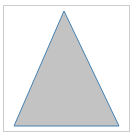To create a polygon, use the polygon tag. The best way to think about an SVG polygon is to compare it to a child's dot-to-dot game. You can imagine a series of dots and a pen connecting each (x, y) coordinate with a straight line. The series of dots is identified in the points attribute. Take the following as an example (http://localhost:8080/chapter-2/polygon.html):

<polygon points="60,5 10,120 115,120"/>
First, we start at 60,5 and we move to 10,120. Then, we proceed to 115,120 and, finally, return to 60,5.
The pen returns to the starting position automatically.



